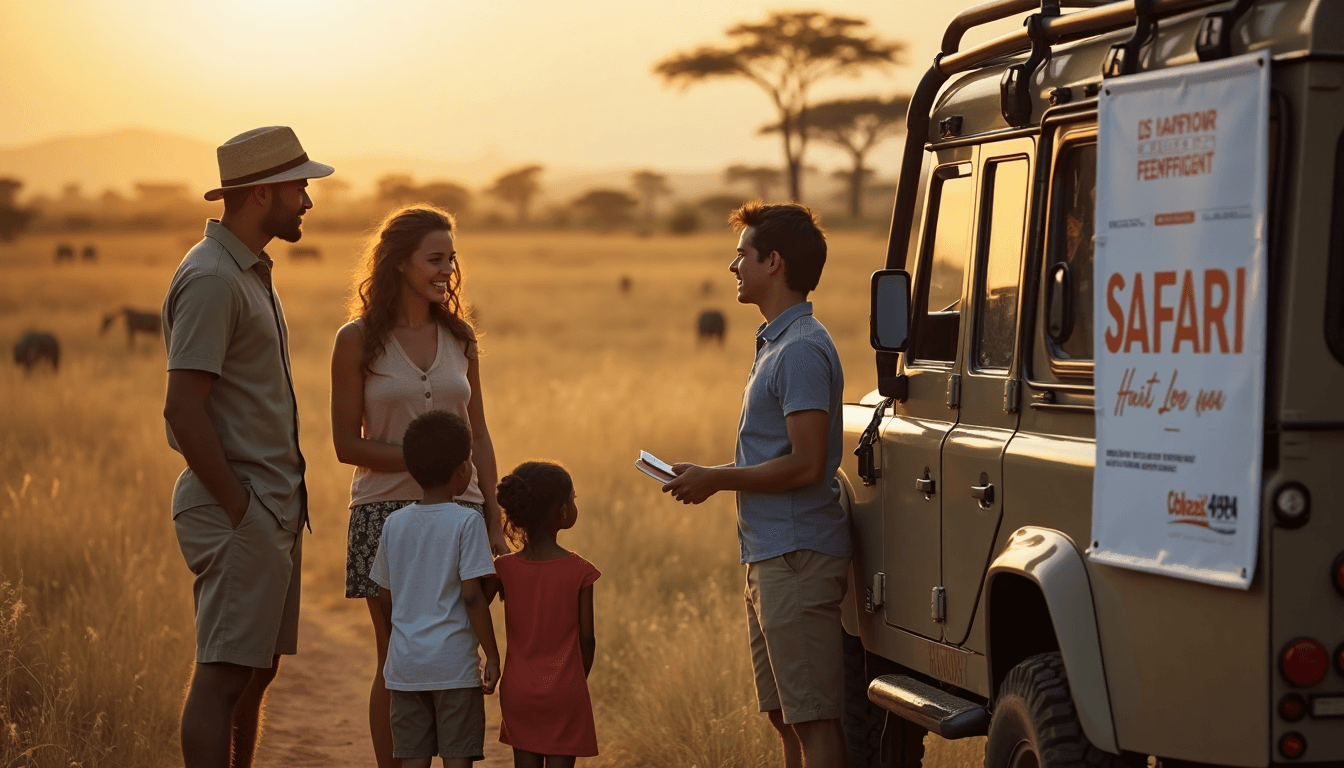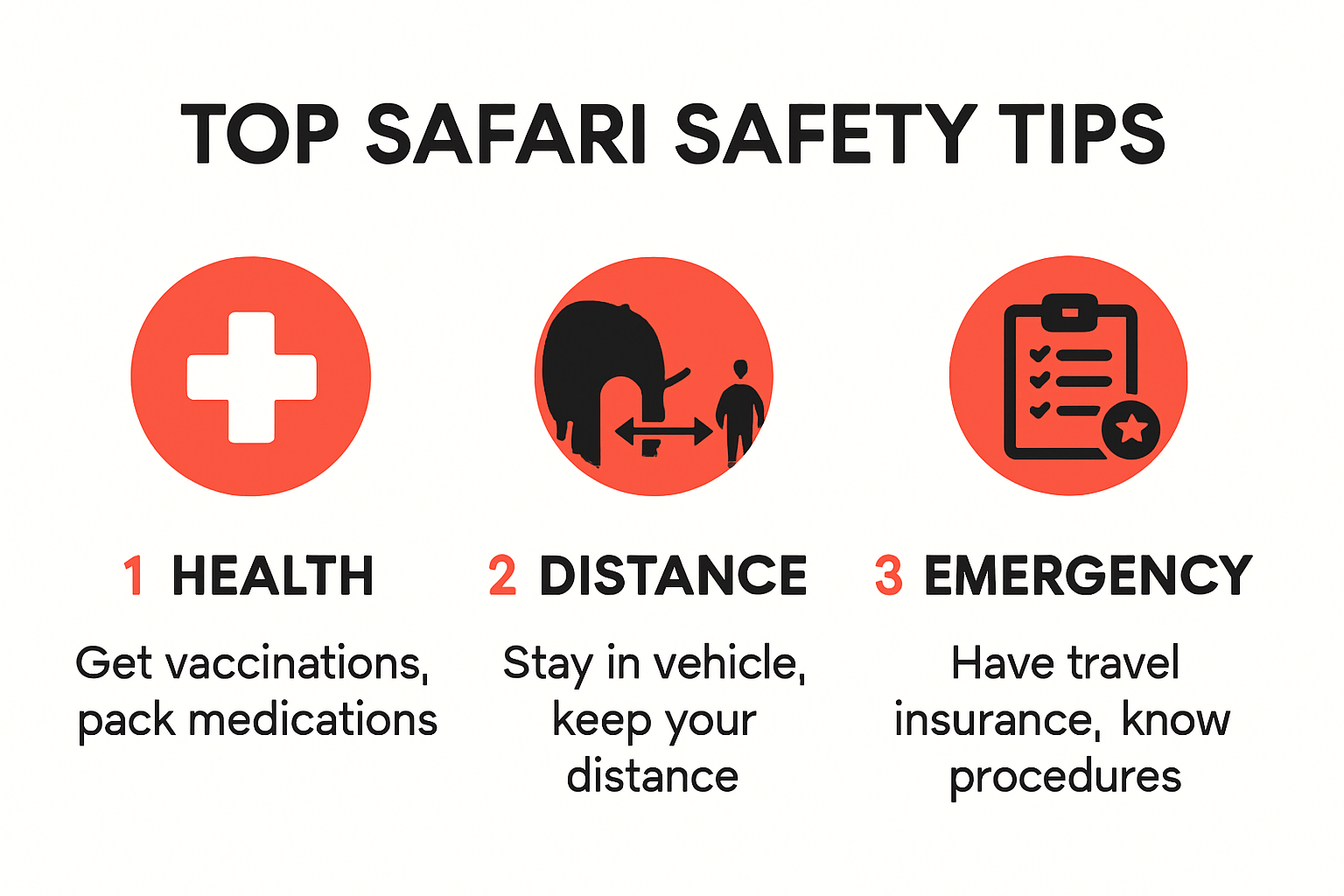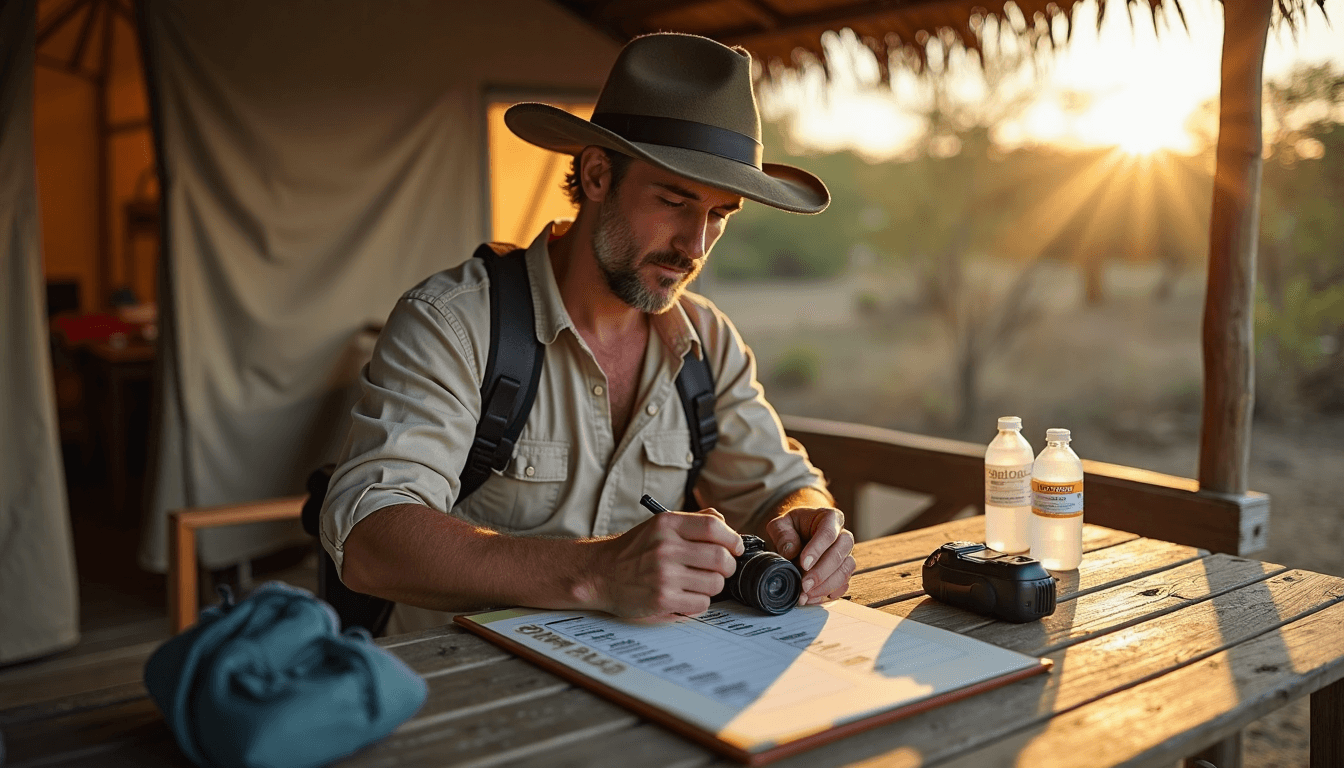Top Safari Safety Tips for a Secure African Adventure 2025
Full Disclosure: Our AI Assistant Writes These!
While we're out in the bush tracking leopards, dodging elephants, and trying to get the perfect sunset shot, our trusty AI companion is back at camp, diligently crafting these blog posts. Don't worry though - it's been trained on years of real safari experiences and only occasionally suggests that tourists should pet the lions. (Please don't pet the lions. The AI was joking. We hope.)
The real reason? SEO loves fresh content, and we love fresh adventures. So while our AI handles the keywords and search rankings, we're out there finding the next hidden waterhole, secret viewpoint, or that one tree where the leopards always hang out. Win-win, really!
Top Safari Safety Tips for a Secure African Adventure 2025

Planning an African safari for 2025 sounds thrilling, especially with new destinations popping up and more travelers than ever chasing adventure. Yet here’s the real surprise. Over 90 percent of safari incidents are preventable, simply through smart preparation and awareness of basic safety protocols. Most people obsess over camera gear or the best park, missing the fact that the biggest difference between a trip full of memories and one derailed by emergencies comes down to knowing a few key safari safety tips. Here’s what most guides don’t tell you up front.
Table of Contents
- Preparing For A Safe Safari Experience
- Understanding Wildlife Safety Guidelines
- Travel Tips For Different Safari Groups
- Health And Emergency Planning In The Wild
Quick Summary
| Takeaway | Explanation |
|---|---|
| Prioritize Health Preparations | Consult healthcare professionals weeks before departure to ensure vaccinations are up to date and discuss malaria prophylaxis. Carry a comprehensive medical kit with essential supplies. |
| Maintain Safe Wildlife Distances | Keep a minimum distance of 25 yards from most wildlife and 100 yards from predators, using binoculars for close observation while following your guide’s instructions. |
| Tailor Safety for Travel Groups | Adopt specific safety strategies based on the type of traveler, whether solo, family, or specialized groups, including sharing itineraries and establishing clear communication protocols. |
| Comprehensive Emergency Planning | Verify included emergency evacuation services, develop a detailed communication plan with local contact numbers, and carry essential medical documentation and supplies. |
| Understand Wildlife Interaction Ethics | Avoid feeding wildlife and minimize noise to prevent disrupting their natural behavior, fostering respectful and safe encounters in their habitats. |

Preparing for a Safe Safari Experience
A successful safari adventure requires meticulous preparation and strategic planning. Understanding potential risks and taking proactive measures can transform your wildlife expedition from a potentially challenging experience into an unforgettable journey of discovery and safety.
Health Preparations and Medical Considerations
Prioritizing your health is paramount when preparing for an African safari. The best safari destinations for 2025 demand comprehensive medical readiness. According to the Centers for Disease Control and Prevention, travelers must consult healthcare professionals weeks before departure to ensure proper vaccination and health protection.
Key medical preparations include obtaining necessary vaccinations such as yellow fever, hepatitis A and B, typhoid, and ensuring routine immunizations are current. Travelers should also discuss malaria prophylaxis with their healthcare provider, as different regions require specific antimalarial medications. Carry a comprehensive medical kit including prescription medications, insect repellent, sunscreen, and basic first aid supplies.
Below is a table summarising essential safari health preparations mentioned in this section:
| Health Preparation | Purpose/Details |
|---|---|
| Vaccinations (yellow fever, hepatitis A & B, typhoid, routine immunisations) | Prevent region-specific and common diseases |
| Malaria Prophylaxis | Discuss with healthcare provider for destination-specific medication |
| Comprehensive Medical Kit | Include prescription meds, insect repellent, sunscreen, first aid supplies |
| Consult Healthcare Professional | Obtain up-to-date advice and preparation weeks before departure |
Travel Documentation and Safety Protocols
Securing appropriate travel documentation represents another critical aspect of safari safety preparation. Ensure your passport is valid for at least six months beyond your planned travel dates. Obtain comprehensive travel insurance that specifically covers medical evacuation and emergency medical treatment in remote wildlife areas.
Research and understand local regulations, potential health risks, and entry requirements for your specific destination. Make copies of important documents like passport, insurance cards, and emergency contact information. Store digital backups securely online and carry physical duplicates separately from original documents.
Personal Safety and Equipment Preparation
Selecting appropriate clothing and equipment can significantly enhance your safari safety. Pack lightweight, neutral-colored clothing that provides protection from sun and insects while allowing comfortable movement. Include long-sleeved shirts, convertible pants, wide-brimmed hats, and sturdy walking shoes.
Invest in high-quality, compact safety equipment such as a reliable flashlight, portable water purification system, and communication devices like satellite phones or emergency beacons. Consider carrying a compact first aid kit with essential medical supplies tailored to wilderness environments.
By implementing these comprehensive safari safety tips, travelers can confidently prepare for an extraordinary African wildlife experience. Thoughtful preparation transforms potential challenges into opportunities for remarkable adventure and personal discovery.

Understanding Wildlife Safety Guidelines
Wildlife encounters are the heart of any safari experience, but they demand respect, caution, and a deep understanding of animal behavior. Navigating these interactions safely requires more than simple observation techniques.
Respectful Distance and Observation Protocols
Maintaining a safe distance from wildlife is fundamental to both human safety and animal welfare. According to the National Park Service, travelers should maintain a minimum distance of 25 yards (23 meters) from most wildlife and 100 yards (91 meters) from predatory animals. This guideline prevents unintentional stress or provocative interactions that could trigger defensive responses.
When observing wildlife, utilize binoculars and telephoto camera lenses to get closer visual details without physical proximity. Professional safari guides are trained to interpret animal body language and understand safe observation boundaries. Listen carefully to their instructions and follow them precisely.
The following table provides a summary of recommended minimum distances from wildlife and key observation practices for your safety:
| Wildlife Type | Minimum Distance | Observation Tools/Practices |
|---|---|---|
| Most wildlife | 25 yards (23 m) | Use binoculars/camera; follow guide’s instructions |
| Predators (e.g. lions, leopards) | 100 yards (91 m) | Remain in vehicle; never approach on foot |
| All wildlife | — | Avoid sudden movement/noise; do not feed or disturb |
Understanding Animal Behavior and Warning Signs
Recognizing potential warning signs of animal agitation is crucial for safari safety. Wildlife experts emphasize that animals communicate discomfort through specific behavioral cues. Raised hair, flattened ears, direct eye contact, or sudden movement toward observers are universal signals indicating potential aggression.
Predatory animals like lions, leopards, and cheetahs have distinct behavioral patterns. When they feel threatened or perceive humans as potential competitors, they might display territorial behaviors. Understanding these nuances helps travelers make informed decisions and avoid dangerous confrontations.
Responsible Wildlife Interaction Strategies
Ethical wildlife interaction goes beyond physical distance. The National Park Service recommends minimizing noise and avoiding sudden movements that could startle animals. Quiet, slow, and predictable human behavior helps maintain a calm environment.
Feeding wildlife is strictly prohibited. Such actions can disrupt natural behaviors, create dependency, and potentially lead to aggressive encounters. Wild animals have complex ecological roles, and human interference can have long-lasting consequences on their survival and ecosystem balance.
By adopting these comprehensive wildlife safety guidelines, safari travelers can transform potential risks into opportunities for profound, respectful wildlife encounters. Remember, in the wilderness, you are a guest in the animals’ natural habitat. Approach with humility, curiosity, and an unwavering commitment to safety and conservation.
Travel Tips for Different Safari Groups
Safari experiences are not one-size-fits-all. Each group of travelers brings unique needs, challenges, and expectations that require tailored safety strategies. Understanding these specific considerations can transform your wildlife adventure into a secure and memorable journey.
Solo Travelers and Individual Safety Strategies
Solo safari travelers face distinct safety challenges that demand extra preparation and awareness. Comprehensive safari tours can provide structured environments that mitigate individual risks. According to University of California Davis Global Affairs, solo travelers should prioritize thorough destination research, understanding local customs, and maintaining constant communication with tour operators.
Key safety recommendations for solo travelers include sharing detailed itineraries with emergency contacts, investing in reliable communication devices, and selecting group tours or guided experiences that offer additional layers of protection. Consider joining small group safaris that provide collective security while maintaining personal adventure experiences.
Family and Group Safari Safety Considerations
Families and larger travel groups require coordinated safety approaches that accommodate varying ages and physical capabilities. The Centers for Disease Control and Prevention emphasizes the importance of pre-travel health consultations tailored to each group member’s specific needs.
Establish clear safety protocols within your group, including designated meeting points, communication strategies, and individual responsibility guidelines. For families with children, additional precautions such as age-appropriate wildlife education, careful supervision, and specialized medical preparations become crucial.
Specialized Group Safety Approaches
Different traveler demographics require nuanced safety strategies. Adventure enthusiasts might prioritize more immersive experiences, while luxury travelers may seek controlled environments with enhanced safety measures. Older travelers or those with limited mobility should select safari experiences with appropriate accessibility and medical support.
Consider factors like physical fitness, medical history, and personal comfort levels when selecting safari experiences. Some tours offer specialized options for photographers, wildlife researchers, or specific interest groups that provide tailored safety protocols and unique encounter opportunities.
By recognizing and addressing the unique safety requirements of different traveler groups, safari experiences can be both thrilling and secure. Thoughtful preparation, comprehensive research, and selecting appropriate tour options transform potential challenges into extraordinary adventures across Africa’s magnificent wilderness.
Health and Emergency Planning in the Wild
Safari adventures demand comprehensive health and emergency preparedness. The unpredictable nature of wilderness environments requires travelers to develop robust strategies that address potential medical challenges and ensure rapid response capabilities.
Medical Preparedness and Preventive Strategies
Comprehensive medical preparation is critical for safari safety. According to the Centers for Disease Control and Prevention, travelers must undergo thorough pre-travel medical consultations to receive necessary vaccinations and health guidance. Key preventive measures include obtaining immunizations for yellow fever, hepatitis A and B, and ensuring routine vaccinations are current.
Malaria prevention represents a crucial aspect of safari health planning. Medical experts recommend prescribed antimalarial medications, combined with comprehensive protective strategies such as using insect repellent, wearing long-sleeved clothing, and sleeping under treated mosquito nets. Travelers should consult healthcare providers to determine the most appropriate antimalarial protocol for their specific destination and individual health profile.
Emergency Response and Medical Evacuation Planning
Effective emergency planning requires a multifaceted approach. Comprehensive safari tours often include emergency evacuation services, but travelers should independently verify and supplement these provisions. Carry a comprehensive medical kit containing prescription medications, basic first aid supplies, emergency communication devices, and copies of critical medical documentation.
Develop a detailed emergency communication plan that includes local emergency contact numbers, nearest medical facilities, and satellite communication options. Consider investing in travel insurance that specifically covers medical evacuation from remote wilderness areas. Understand the limitations of medical facilities in your destination and prepare accordingly by carrying essential medications and medical supplies.
Wilderness Health Management Techniques
Managing personal health in wilderness environments requires specialized knowledge and preparation. Travelers must be vigilant about hydration, sun protection, and managing potential environmental health risks. Carry water purification systems, electrolyte replacement solutions, and understand techniques for preventing heat-related illnesses.
Be prepared to address potential health challenges such as altitude adaptation, extreme temperature variations, and limited access to medical facilities. Learn basic first aid techniques and wilderness medical management strategies. Carry a comprehensive first aid kit tailored to the specific environmental conditions of your safari destination.
Successful safari health management combines proactive preparation, comprehensive medical knowledge, and adaptable emergency planning. By implementing these strategic approaches, travelers can minimize health risks and focus on experiencing the extraordinary wildlife and natural wonders of their African adventure.
Frequently Asked Questions
What health preparations should I make before going on a safari in 2025?
Prioritize health preparations by consulting healthcare professionals weeks before your trip. Ensure vaccinations are up to date, discuss malaria prophylaxis, and carry a comprehensive medical kit with essential supplies.
How far should I stay from wildlife during a safari?
Maintain a minimum distance of 25 yards from most wildlife and 100 yards from predators. Use binoculars for close observation and always follow your guide’s instructions.
What safety tips should solo travelers consider for a safari?
Solo travelers should share detailed itineraries with emergency contacts, invest in reliable communication devices, and consider joining group tours for additional safety and support.
How can I prepare for medical emergencies while on safari?
Ensure you have comprehensive travel insurance that covers medical evacuation. Carry a well-stocked medical kit, develop an emergency communication plan, and research local medical facilities before your trip.
Turn Safari Safety Tips Into Your Next Lifelong Adventure
You have read all the right tips for staying secure on safari. But what if getting peace of mind was as simple as booking with people who live these safety practices every day? At Africa Awesome, your adventure is guided by experts who design every itinerary around up-to-the-minute health protocols, local wildlife insight, and emergency planning. Whether you are heading out as a solo explorer, with your family, or as part of a group, you get more than advice. You get real backup from people who understand the unique demands of every traveller.

Ready to trade worry for wonder? Chat directly to a local travel specialist or explore our curated safari tours crafted with built-in safety features and flexible booking. Visit Africa Awesome now. Secure your 2025 safari while top spots are still available, and experience the best of Africa—stress free.
Recommended
- Blog - Africa Awesome
- Best South African Safari Destinations for 2025 Adventures
- Africa Awesome - Premier Overlanding Safari Tours & Experiences
- All African Safari Tours & Adventures | Africa Awesome
- All African Safari Tours & Adventures | Africa Awesome
- All African Safari Tours & Adventures | Africa Awesome